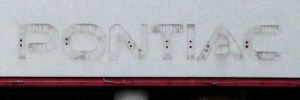















Pontiac brake caliper: hydraulic devices for an excellent braking assist |
|---|

|
Anthony Fontanelle
September 11, 2007
Among the most important parts of your Pontiac vehicle is the braking system. This collective system of components keeps you safe on the road, because it prevents your car from engaging in an accident. As a unit, your braking system slows or stops your car as the need arises. But how do they work? Actually, this group of safety components works through hydraulic force multiplication and mechanical advantage or leverage. Using friction, the braking system transmits force to the tires. The tires in turn, transmit the force to the road using the same friction. Since your entire braking assembly is a complex system, it would not be ale to work out its function if one or more of its sub components are not in good working condition. You need to ensure that every braking system component is kept maintained and regularly inspected. That way, you can be sure that there is very little chance of having a braking failure. And when there is very minimal braking failure, car accidents are definitely prevented from happening.
The Pontiac brake caliper is among the various components comprising your entire braking system that plays an indispensable role. Also known as a brake clamp, this car component does the job of clamping down the rotor whenever you apply the brakes. It is a U-shaped device that activates the pistons on its sides whenever the high pressure brake fluid is channeled from the master cylinder to this car part. The pressing action of the Pontiac brake caliper allows your car to slow down or to stop because of the friction generated. This braking system component can be seen attached to the wheel hub, holding the brake pads. You can also see this braking system part straddling the brake rotors that spin around together with your tires. Your car is typically made up of two brake calipers—the front and rear brake caliper. Each brake caliper has a brake pad attached on top of its piston. Aside from that, the brake discs can also be seen lined inside this braking system part.
There are 2 types of brake calipers: the floating caliper and the fixed brake caliper. Also known as the sliding caliper, the floating caliper moves in a track so it can enter over the rotor. On the other hand, fixed calipers are not allowed to move because they are mounted rigidly to the support. You can find this type of brake caliper on high performance and expensive luxury cars. The brake caliper stops your wheels that spin at thousands of RPM, so it is likely to wear out eventually. During excessive amounts of braking, it is possible for your Pontiac brake caliper to become overheated. The accumulation of brake fluid on the brake caliper can cause rust that can prevent them from functioning properly. Aside from that, ozone exposure and old age can also lead to deterioration of your Pontiac brake caliper. It can cause some leaks, which could lose your ability to stop your car. To prevent this from happening, it is highly recommended that you replace your stock brake caliper after every 100,000 miles of driving, and give it proper car maintenance as well.
Source: Amazines.com
